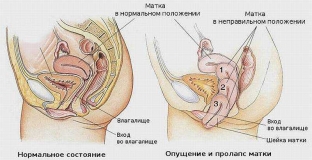The birth of a child is perhaps one of the most amazing and beautiful physiological processes that occur in nature. Many structural features of the female body are focused directly on making the period of pregnancy and labor possible. However, gynecological pathology can develop even in connection with these physiological processes. Uterine prolapse is one of the most common pathological processes among anomalies in the position of the genital organs. Some pathologies, including traumatic childbirth, can cause such a pathological condition of the reproductive system.
Clinical picture of uterine prolapse: early signs of the disease
Prolapse and prolapse of the uterus accounts for about 30% of all anomalies in the position of the female genital organs. The concept of prolapse of the uterus implies the displacement of the internal genital organs of a woman into the vaginal cavity, and even their prolapse to the outside. Due to the anatomical proximity of all supporting structures, this pathology often causes anatomical failure of organs adjacent to the internal reproductive organs of a woman, and therefore conditions such as urinary incontinence or anal sphincter failure can develop. The clinical picture of uterine prolapse is so specific that there are often no special difficulties in diagnosing this disease.
Prolapse of the uterus:
- etiological factors of uterine prolapse;
- classification of uterine prolapse according to the position of the organs;
- characteristic symptoms indicating uterine prolapse.
Etiological factors of uterine prolapse
Prolapse and prolapse of the uterus and vagina is a polyetiological disease, which is based on the failure of the muscles of the small pelvis and the ligamentous apparatus of the uterus. Increased intra-abdominal pressure also plays an important role in the development of pathology. Among the main causes leading to the occurrence of uterine prolapse are:
- traumatic childbirth;
- systemic insufficiency of the connective structures of the small pelvis: a combination of pathology with hernias of other localizations, prolapse of other internal organs;
- hormonal disorders: insufficient estrogen production;
- chronic processes that are accompanied by impaired microcirculation and metabolism in the body.

Classification of uterine prolapse according to organ position
Prolapse of the uterus is classified according to how much this organ is displaced downwards. There are 3 degrees of prolapse of the uterus and vagina:
- In the first degree, the walls of the vagina descend to the entrance to the vagina, there is an external os of the cervix, located below the spinal spines.
- In the second degree of uterine prolapse, the cervix extends beyond the genital slit, but the body of the uterus is located behind the genital slit.
- In the third degree, there is a complete prolapse of the uterus - the entire uterus is outside the genital gap.
Characteristic symptoms suggestive of uterine prolapse
Uterine prolapse is a gynecological disease that develops slowly and gradually. The most common complaint during the initial visit of the patient to the gynecologist is the discovery by the woman herself of a foreign body in the vagina. Over time, the patient develops pain in the lower abdomen, in the lower back and sacrum, which increases significantly with any physical exertion, weight lifting, and even coughing and sneezing. Very often, prolapse of the uterus is combined with the pathology of the urinary system: women experience difficulty urinating, inflammatory diseases of the urinary system. Every third patient with uterine prolapse has violations of the act of defecation in the form of permanent constipation. Visually, the surface of the prolapsed organs looks like dry skin with cracks, abrasions and ulcerations.






Add a comment